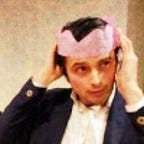Pouring Concrete Poetry
I stubbed my toe on some visual/concrete poetry this week. Hiromi Suzuki makes visual poetry which obscures and opens up options for meaning. The below .gif works by representing both the telephone lines, and the undulations of singing. Reading between the lines (sorry) finds the play and the enjoyment in the image. It’s a kind of pun.
Concrete poetry’s genesis is often credited all the way back to The Altar, by George Herbert. The idea is that the poetry changes in it’s mean by being presented in a different way. At one end of the scale there is the oral tradition, at the other, this visual tradition.
It is the attempt to turn the poem into an object.
In Herbert’s poem, it is novel because it is the shape of an altar, while also containing the metaphor of functions of the altar and how Christians offer themselves as not only a sacrifice to god’s will, but also as a method of performing these sacrifices.
We ascribe additional sentimental value to anything that makes us feel something while being something. An object-poem gives us context and a sense of permanence — in the same way that the tall hat-stand used by your short grandmother has a little bit of her using it attached as memory, concept, sentiment.
In the halls of my university hung a few pieces by Eugen Gomringer:
This is something like: flowers, spring, test, above — somehow the shape of spring and the blooming ebb and flood of nature is meant to be represented here.
As with this, mercifully in English, you’re not only asked the question — but then you begin to interrogate the idea of how the question is asked. The joke folds on itself neatly. The object is like a kind of puzzle that you can feel, move about, reconfigure — put down, and then re-approach another day.
Much like when you live with art, these poems are ones you can live with in the same way — to wander past, see it in all light at all times in all moods. You change the object a little in your relationship with it.
In December last year I went to see the Rauschenberg retrospective at the Tate modern. It was excellent, especially for someone who hadn’t really engaged with him before. A key feature of a lot of Rauschenberg’s work is to mix media, to make what he termed “combines”. These often include texts (whether found, foraged or created) and give you a way to engage with it that’s exploratory. You peer at the work unpicking the text from the sculpture, the paint from the found objects.
Rauschenberg and the concrete poetry above creates meditative objects which encourage a kind of exploration through form which you can’t usually gather through traditional presentations. You are not always invited to explore a poem which is to be consumed in a linear form, and visual mediums can be equally as transactional. To get more out of either, you need to apply the context of the world — whereas the combines of Rauschenberg and the concrete poetry above provide tools for engagement within themselves.
Gerhard Ritcher, more famous for his abstract paintings drawings, seemed to like to a little bit of cartoon drawing. These drawings have been found, and they’re lovely.
To follow on from last week’s Etch to their Own, go download editions of DADA magazine, over here.
Etch To Their Own #5 was composed in the normal fashion by @CJEggett and edited by no one. If you want to get in touch to tell me about a typo, tell me I’m wrong, or tell me to have a look at your poetry — reply to this email, or @ me. You can read old issues here which are free to print out, remix and publish on your own domain to produce great wealth for yourself, and your family. Except for the parts which I do not own.
